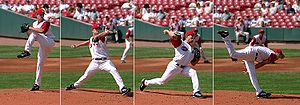
Work (physics)
Did you know...
This Schools selection was originally chosen by SOS Children for schools in the developing world without internet access. It is available as a intranet download. To compare sponsorship charities this is the best sponsorship link.
In physics, mechanical work is the amount of energy transferred by a force. Like energy, it is a scalar quantity, with SI units of joules. The term work was first coined in the 1830s by the French mathematician Gaspard-Gustave Coriolis.
According to the work-energy theorem if an external force acts upon an object, causing its kinetic energy to change from Ek1 to Ek2, then the mechanical work (W) is given by:
where m is the mass of the object and v is the object's speed.
The mechanical work applied to an object can be calculated from the scalar multiplication of the applied force (F) and the displacement (d) of the object. This is given by:
Introduction

Work can be zero even when there is a force. The centripetal force in circular motion, for example, does zero work because the kinetic energy of the moving object doesn't change. Likewise, when a book sits on a table, the table does no work on the book, because no energy is transferred into or out of the book.
Heat conduction is not considered to be a form of work, since there is no macroscopically measurable force, only microscopic forces occurring in atomic collisions.
Units
The SI unit of work is the joule (J), which is defined as the work done by a force of one newton acting over a distance of one meter. This definition is based on Sadi Carnot's 1824 definition of work as "weight lifted through a height", which is based on the fact that early steam engines were principally used to lift buckets of water, through a gravitational height, out of flooded ore mines. The dimensionally equivalent newton-meter (N·m) is sometimes used instead; however, it is also sometimes reserved for torque to distinguish its units from work or energy.
Non-SI units of work include the erg, the foot-pound, the foot-poundal, and the liter-atmosphere.
Mathematical calculation
Force and displacement
Force and displacement are both vector quantities and they are combined using the dot product to evaluate the mechanical work, a scalar quantity:
 (1)
(1)
where  is the angle between the force and the displacement vector.
is the angle between the force and the displacement vector.
In order for this formula to be valid, the force and angle must remain constant. The object's path must always remain on a single, straight line, though it may change directions while moving along the line.
In situations where the force changes over time, or the path deviates from a straight line, equation (1) is not generally applicable although it is possible to divide the motion into small steps, such that the force and motion are well approximated as being constant for each step, and then to express the overall work as the sum over these steps.
The general definition of mechanical work is given by the following line integral:
 (2)
(2)
where:
The expression δW=F·ds is an inexact differential which means that the calculation of WC is path-dependent and cannot be differentiated to give F·ds.
Equation (2) explains how a non-zero force can do zero work. The simplest case is where the force is always perpendicular to the direction of motion, making the integrand always zero. This is what happens during circular motion. However, even if the integrand sometimes takes nonzero values, it can still integrate to zero if it is sometimes negative and sometimes positive.
The possibility of a nonzero force doing zero work illustrates the difference between work and a related quantity, impulse, which is the integral of force over time. Impulse measures change in a body's momentum, a vector quantity sensitive to direction, whereas work considers only the magnitude of the velocity. For instance, as an object in uniform circular motion traverses half of a revolution, its centripetal force does no work, but it transfers a nonzero impulse.
Mechanical energy
The mechanical energy of a body is that part of its total energy which is subject to change by mechanical work. It includes kinetic energy and potential energy. Some notable forms of energy that it does not include are thermal energy (which can be increased by frictional work, but not easily decreased) and rest energy (which is constant as long as the rest mass remains the same).
If an external force F acts upon a body, causing its kinetic energy to change from Ek1 to Ek2, then:
Thus we have derived the result, that the mechanical work done by an external force acting upon a body is proportional to the difference in the squares of the speeds. (It should be observed that the last term in the equation above is  rather than
rather than  .)
.)
The principle of conservation of mechanical energy states that, if a system is subject only to conservative forces (e.g. only to a gravitational force), or if the sum of the work of all the other forces is zero, its total mechanical energy remains constant.
For instance, if an object with constant mass is in free fall, the total energy of position 1 will equal that of position 2.
where
 is the kinetic energy, and
is the kinetic energy, and is the potential energy.
is the potential energy.
The external work will usually be done by the friction force between the system on the motion or the internal-non conservative force in the system or loss of energy due to heat.





